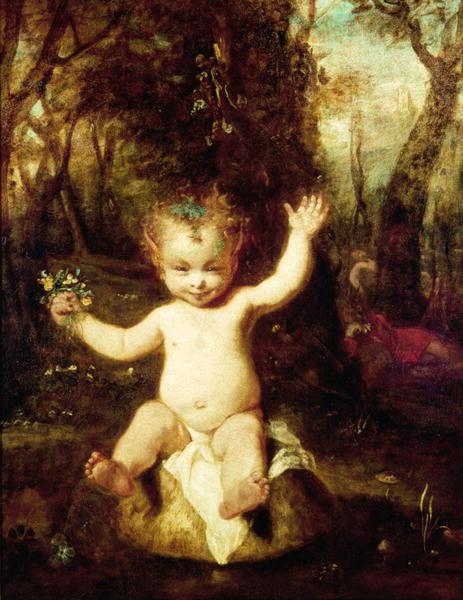Description
Joshua Reynolds's "The Puck" (1789), also known as "The Puck," embodies the mastery of portraiture and visual narrative that characterized the art of 18th-century England. In this painting, Reynolds captures the essence of Puck, a central character in Shakespeare's play, "A Midsummer Night's Dream." Although the depiction of Puck is interpretive, it evokes the mischievous and magical essence that the character has been described as throughout literature.
At first glance, the composition is structured in a balanced way, with the visual focus falling on the central figure, a young man with a smiling face that gives off an air of mischief. His posture, evoking carefree movement, is part of the portrait tradition, although charged with a playful energy that challenges the typical stillness of this art form. The figure is dressed in fine clothing, which reinforces his status, and the care in the execution of these textile details is characteristic of Reynolds' style, whose skill in depicting texture is remarkable.
The use of colour in The Disc is noteworthy. The palette is composed of warm, earthy tones, which bring the figure to life in an environment that, although not completely defined, suggests a connection with nature through the soft tones of the background. Shades of green and brown are glimpsed, creating an almost magical atmosphere, in keeping with the theme of the work. This chromatic choice not only highlights the figure of Puck, but also suggests playing a role in creating a familiarity with the natural world, a concept that often accompanies the environment of the Shakespearean universe.
The character's face, with a lively and charming expression, is drawn with a direct gaze that invites the viewer to share in his secret. Reynolds' mastery of the representation of emotions is manifest here in the subtlety of the smile and the lively look in the eyes, which are also reflections of his mischievous nature. The subtle play of light and shadow on his features gives depth and three-dimensionality, a testament to his technical mastery.
Joshua Reynolds, who was a prominent figure in the development of 18th-century British portraiture, dedicated his life to investigating the possibilities of color and lighting, and The Disc is a clear manifestation of these interests. His technique of “impasto,” or the application of paint in thicker layers, gives the work a tangible quality that invites visual interaction. He was part of the movement that sought to elevate portraiture to an art form where not only the outward appearance but also the inner personality of the subject could be conveyed.
In a broader context, The Disc can be seen as a work that reflects the transition between neoclassicism and romanticism in European art. The fusion of elements of nature and the evocation of legend and mythology represent an aesthetic shift that would give way to new concerns in 19th-century art. This interest in the fantastic and the emotional is found not only in Reynolds' work, but also in his contemporaries and successors, who would seek to explore the human psyche and the ethereal elements of experience.
In short, “The Puck” is a prime example of Reynolds’ innovation in portraiture, his capture of the essence of Puck’s character, and his ability to evoke emotion through color and composition. While this work may not be as widely recognized as some of his more classic portraits, it remains a fascinating piece that invites reflection on the intersection between literature, art, and the human experience—characteristics that continue to resonate across the centuries.
KUADROS ©, a famous painting on your wall.
Hand-made oil painting reproductions, with the quality of professional artists and the distinctive seal of KUADROS ©.
Painting reproduction service with satisfaction guarantee. If you are not completely satisfied with the replica of your painting, we will refund 100% of your money.

